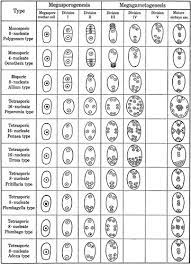Embryo, Embryogeny, Zygote, Proembryo
EMBRYO
The fertilized egg is called zygote Following a predetermined mode f development (embryogeny) it gives rise to an embryo, which has the potentiality form a complete plant. A typical dicotyledonous embryo seen in median longitudinal section. It comprises an embryonal axis with two cotyledons attached to laterally. The portion of embryonal axis above the level of cotyledons is called epicotyl, and the portion below the level of cotyledons is known as hypocotyl. The epicotyl terminates into plumule (embryonic shoot), and the hypocotyl at its lower end bears radicle (embryonic root). The embryo of a monocotyledon differs from that of a dicotyledon mainly in having only one cotyledon. The embryos of grasses show a highly specialized structure. In this chapter the chief structural changes associated with principal types of embryogeny in angiosperms are described. At the end some aspects of the physiology, genetics and nutrition of embryo are discussed.
ZYGOTE:
From the time of its formation the zygote undergoes a period of dormancy which varies greatly with species. Generally, this period is shorter where the endosperm is Cellular than where it is Nuclear. During the dormancy period many striking changes occur, as a result of which the zygote at the end of the dormancy period shows more pronounced polarity than the egg. Soon after syngamy the large vacuole in the zygote starts shrinking. As a result, the cell size is also reduced. This reduction may be minor as in Capsella, or highly significant as in cotton. In the latter, the size of the zygote is reduced to half the original size of the egg within 24 hours after pollination largely due to dissolution of the vacuole. The decrease in cell size causes additional accumulation of cytoplasm at its chalazal end where first division of the zygote will take place. In Arabidopsis thaliana the vacuole becomes fragmented and the zygote elongates 2 to 3-fold before a large vacuole is reassembled (Faure et al., 2002). Another immediate response to syngamy is increase in the number of active dictyosomes which is related to wall synthesis around I the zygote. The ribosomes aggregate to form polysomes, indicating the beginning of metabolic activities. The zygote, ready to divide, highly wall, which was restricted to the highly polarized, isolated cell. The micropylar end of the egg before is now complete around the zygote. It becomes an isolated cell fertilization, is in the sense that the plasmodesmatal connections with the surrounding cells are blocked. The nucleus, surrounded by a large number of plastids and mitochondria, is located at the chalazal region of the cell (apical pole). The micropylar end of the zygote (basal pole) is occupied by one or more vacuoles, and the number of cell organelles in this region is extremely small.
EMBRYOGENY:
In the majority of angiosperms the zygote divides
transversely, resulting in a small apical cell (conventionally designated ca)
toward the interior of the embryo sac and a large basal cell (conventionally
designated cb) toward the micropyle. Rarely, the division of the zygote may be
vertical (Loranthaceae) or oblique (Triticum sp). The variations in the
developmental pattern of embryo during early embryogeny are common to
monocotyledons and i dicotyledons. Differences appear when the initials of
plumule and cotyledon(s) are laid down. From the 2-celled stage until the
initiation of organs the embryo is commonly called proembryo.
PROEMBRYO:
In a 2-celled proembryo, the basal cell (ch) either remains undivided, or it undergoes a transverse division to form two cells, m and ci. In the latter case, depending on whether the division of the apical cell (ca) is transverse or vertical, the 4-celled proembryo is linear or T-shaped, In the linear proembryo the two daughter cells of ca (1, 1), by two vertical divisions at right angles to each other, give rise to an octant with two superposed tiers (1, 1) of four cells each. An octant of similar configuration is formed by the T-shaped proembryo by one transverse division included and one vertical division. The T-shaped proembryo can also form an octant of a different configuration, in which all the eight cells a in the same tier (q); an axial quadrant is surrounded by four peripheral cells. Thus, in angiosperms two types of octant configurations occur (a) the component cells are arranged in two superposed tiers of 4-cells each (Beta, Capsella, Poa, Sagittaria), and (b) all the 8-cells occur in a single tier (Lactuca, Muscari). As is evident from the cited examples, both types of octants occur in monocotyledons as well as in dicotyledons. It is at the octant stage of the proembryo that the destinies of various cells become determined.
PSEUDO EMBRYO SAC:







Comments